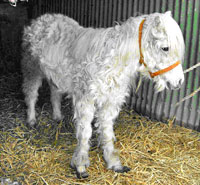 Cushing’s is a disease that many horse owners are familiar with by name, and a few people are able to recognise the classic clinical signs of the disease. Those of you that also have dogs may have come across the disease in this species. However, the name ‘Cushing’s’ is quite misleading as the disease in horses is different to that in dogs. Veterinarians have chosen to refer to the disease in horses as equine Pituitary Pars Intermedia Dysfunction (PPID) as this is a more descriptive name for the disease, referring to the part of the brain responsible for the disease.
Cushing’s is a disease that many horse owners are familiar with by name, and a few people are able to recognise the classic clinical signs of the disease. Those of you that also have dogs may have come across the disease in this species. However, the name ‘Cushing’s’ is quite misleading as the disease in horses is different to that in dogs. Veterinarians have chosen to refer to the disease in horses as equine Pituitary Pars Intermedia Dysfunction (PPID) as this is a more descriptive name for the disease, referring to the part of the brain responsible for the disease.
Clinical Signs
PPID is a disease of older horses. The youngest horse known to have PPID was 7 years old, but the average age of affected horses is 19 years old. The most common clinical sign is referred to as hirsutism, which means abnormal hairiness. The abnormal haircoat can vary from delayed shedding of the winter coat to the presence of a long curly coat, as well as patchy hair growth with areas of alopecia (no hair). This is the only clinical sign that is considered to be specific for the disease. There are many other clinical signs associated with the disease, which can also have many other causes. These include excessive sweating, increased drinking and urination, abnormal respiratory sounds and effort, increased appetite, lethargy, infertility, and bulging of the supraorbital fat pads. Affected horses also develop an altered body shape with a pendulous abdomen, due to a loss of muscle definition and tone. Some of the most serious clinical signs and consequences of the disease include blindness, seizures, recurrent infections (subsolar abscess, sinus infection and tooth root infections), and laminitis.
Cause
The cause of PPID is a hormone imbalance, which causes the part of the pituitary gland, known as the pars intermedia, in the brain to enlarge. The pars intermedia is responsible for secreting a variety of hormones itself. Dopamine is the hormone that acts on the pars intermedia, to suppress hormone secretion. Due to reduced suppression by dopamine, the pars intermedia increases in size and over-secretes the hormones it is responsible for producing. The clinical signs of PPID are a consequence of both the increase in size of the pars intermedia, causing compression of surrounding parts of the pituitary gland and brain (e.g. blindness, seizures), and due to the effects of the excess hormones on the body (e.g. laminitis, recurrent infections).
Diagnosis
An older horse with hirsutism (abnormal hairiness) has a greater than 90% likelihood of having PPID. However, there are laboratory tests available that can help diagnose the disease in those cases that are not as clear cut, such as horses that have other clinical signs of PPID but not hirsutism, and also to confirm the diagnosis. The most reliable test for diagnosing PPID is known as the dexamethasone suppression test. In the afternoon a sample of blood is collected and then dexamethasone (a synthetic steroid) is administered. The following morning a second blood sample is collected. The blood samples are tested for concentrations of the hormone cortisol. In normal horses the administration of dexamethasone causes the concentration of cortisol to be reduced. However, in horses with PPID the cortisol concentration remains high. This test cannot be performed in the autumn months as false positives occur, which means that horses that are clinically normal test positive for PPID. The reason for this is unknown, but it is proposed that cortisol production is upregulated in autumn in normal horses to prepare the horse’s body for the cooler months, by promoting hair growth, etc.
Treatment
Horses that are only mildly affected by PPID can often be managed conservatively with supportive care, such as clipping to remove the excess hair and hopefully reduce the excessive sweating, regular dental checks, regular foot trimming and shoeing as needed, and treating any infections quickly and aggressively. However, some horses need medication to improve their clinical signs and quality of life. The most effective drug is called pergolide. It has to be administered orally once every day and is available as capsules or as a liquid. Horses are started on a low dose. If, after 4-6 weeks, it does not appear to be improving the horse’s clinical signs, the dose can be increased until an effective dose is reached. Other drugs are available but are less effective, more expensive, and more difficult to administer. Unfortunately some horses do not respond to any form of treatment and their quality of life is poor, so euthanasia is necessary. However, the majority of affected horses can be managed either with or without treatment and can live a long and happy life with PPID.









